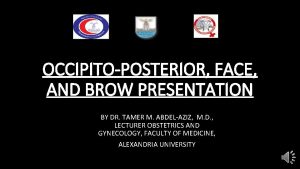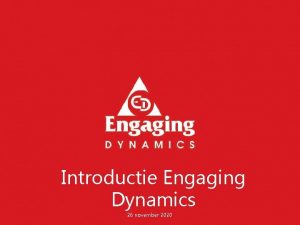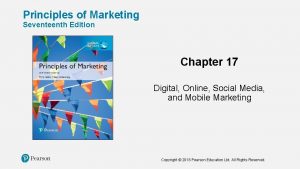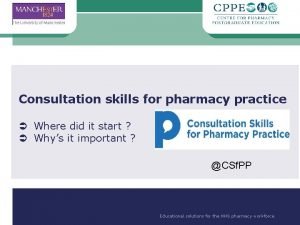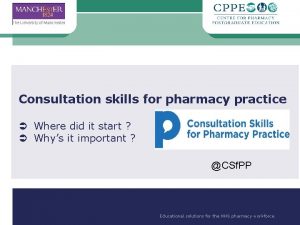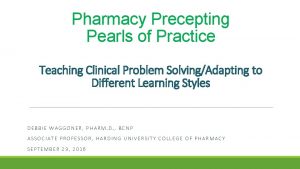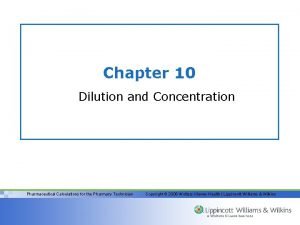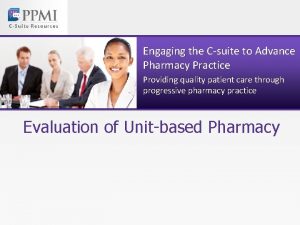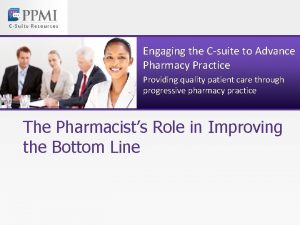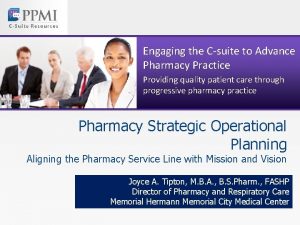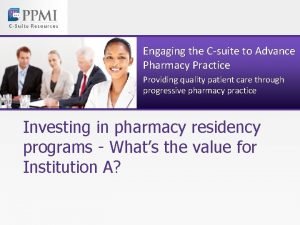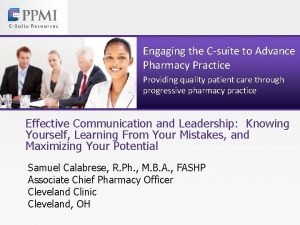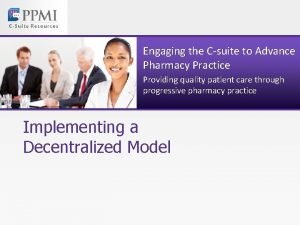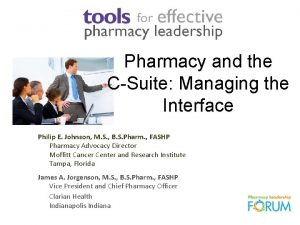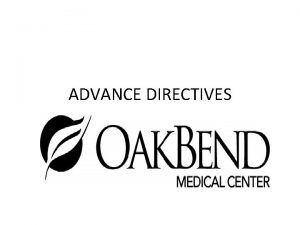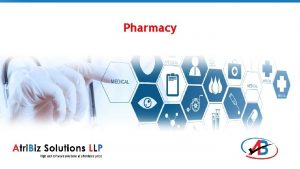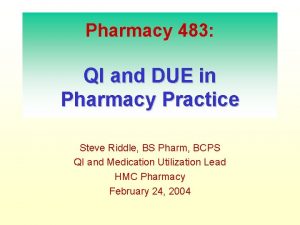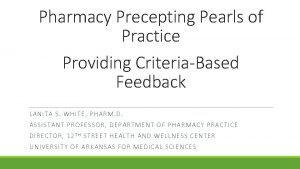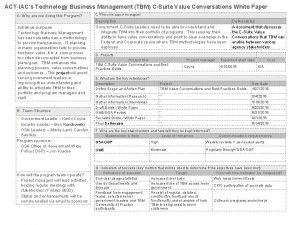Engaging the Csuite to Advance Pharmacy Practice Providing















































- Slides: 47

Engaging the C-suite to Advance Pharmacy Practice Providing quality patient care through progressive pharmacy practice Pharmacy and the C-suite: Managing the Interface The Evolving Health Care Model: Leading Change With The C-Suite Philip E. Johnson, M. S. , B. S. Pharm. , FASHP Oncology Director, Premier Inc. Committee on Clinical Leadership, AHA

Learning Objectives • Describe the evolving healthcare market and the emerging challenges and opportunities for Pharmacy to collaborate with the C-Suite • Describe the priorities of C-Suite executives and explain the relationship of these priorities to your departmental goals. • Define the emerging value proposition for Pharmacy and how to sell it to senior executives.

Understanding the C-Suite • Who are they? • What do they worry about? • What do they expect? • What do they need to know?

C-Suite Composition VP of Pharmacy CIO Chief Information Officer CQO THE CORE Chief Quality Officer CEO-Chief Executive Officer COO-Chief Operating Officer CFO-Chief Financial Officer CMO-Chief Medical Officer CNO-Chief Nursing Officer CPO Chief Purchasing Officer Data on file from CEO interviews and PCAB Surveys. OTHER STAKEHOLDERS CSO Chief Safety Officer

C-Suite Focus Financial Risk More Patients, Less Money, Shifting Payment Models Liability Risk Patient Safety / Quality of Care / Reputation / Litigation Acquisitions and Mergers Job Security / Power Grid Everything Else

Eight Things You Need To Know Today To Engage The C-Suite 1. C-Suite priorities are: a. b. c. d. Cost / Margins (Financial Risk) Patient / Payer Satisfaction (Reputation and Market Share) Quality and Safety (Litigation and Reputation) Acquisitions and Mergers (Job Security vs Career Growth) 2. Is my team Engaged and Accountable? a. Future leadership is #1 concern of American Hospital Association b. Recognize rise in capability of Pharmacists / ASHP leadership training 3. US Healthcare model is not sustainable a. b. c. d. Cost, Quality / Outcomes, Access, Inefficiency / Waste Change is exponential, unpredictable, and a future model is not clear New stakeholders and a shift in power Acquisitions and Consolidations within all stakeholder groups

Eight Things You Need To Know Today To Engage The C-Suite 4. Patients are increasingly medically informed, IT connected, and demanding. a. How can we create patient responsibility and accountability? 5. Employers are increasingly driving decisions a. Work and social productivity are measurable outcomes b. Direct quality / at risk contracts with providers 6. Information sharing, pertinent data are essential, but lacking today a. IT will not lead innovation, as long as we continue to pay for mediocrity b. Cost of inefficiency and fragmentation must reflect IT value analysis c. Providers cannot compete without relevant data d. Providers cannot assume risk without relevant data 7. Drug and supply costs are rising at an unstainable rate a. b. Value based / Risk shared payment models are inevitable Pharma will not collaborate as long as we pay disproportionate prices compared to the rest of the world

Eight Things You Need To Know Today To Engage The C-Suite 8. Pharmacy has a strong value proposition a. b. c. Only if we quantify it Are bold enough to assert it Hold ourselves accountable. Bottom Line: Providers cannot be at Risk if they aren’t equipped with knowledge (data), with a method to guide decisions and analyze outcomes, and a contract that rewards “doing the right thing”. “Where does Pharmacy add Value” is the basic question behind everything we do, and every new opportunity.

The Emerging World Order The Pace of Change is Exponential

The Game Changers • American Recovery and Reinvestment Act of 2009 (The “Stimulus”) – Requires Meaningful Use of Health Information Technology • Affordable Care Act of 2010 (Obamacare) – Medicaid Expansion – Insurance Exchanges – High Deductible Health Plans – Guaranteed Health Insurance Promises – Minimum Essential Benefits (Prevention, Maternity, Mental) • Budget Control Act of 2011 (The Sequester) – Reduces Medicare Payments to Hospitals • American Taxpayer Relief Act of 2013 (The Fiscal Cliff) – Reduces Medicare Payments to Hospitals, to Avoid Tax Increases • Government Power Shift from 2014 Election • Change and controversy won’t stop, ever ……………. . ! Batchelor, “Leadership and Culture: Building Highly Reliable Systems of Care”, ASHP Leadership Conference, Oct 20, 2014, Chicago, IL

Deloitte: What To Expect – ACA Impact • • Medicare will cut reimbursement to hospitals Medicaid will expand dramatically Employers become more active shoppers Manufacturers create new deals with hospitals – Value based – Shared risk • Bad debt increases as margins for patient care shrink – Radical cost-reduction – Risk management – “Go big or get out” leading to a few very large groups • Insurers will play hardball with hospitals – Some hospitals will “go at risk” • Physicians will seek cover – New alignment with hospitals or large “group practices” Paul Keckley, Deloitte Center for Health Solutions, 2014

Oncology As The Forerunning Model ASCO Projections From 2010 To 2020 • 13. 8 to 18. 1 million cancer patients – 45% increase in new cases annually – Cancer becomes the leading cause of death in US • $104 billion to $173 billion annual cost of cancer drugs – Associated drug therapy costs rise 27% – More than 400 drugs in oncology related pipeline – Most new drugs are biologic with genetic target • 20% to 65% Site of Care from MD Offices to Hospitals • Therapy choice determined / paid differently – From Protocols to Pathways to Genomic / Proteomic Testing – From Fee For Service to Episodic Bundles to Population Health • Many cancers have become a chronic disease – 35% increase in number of survivors (18 million by 2022) – Estimated cost of survivor year = $16, 000 American Society of Clinical Oncology. J Oncol Pract. 2014; 10: 119 -42.

Continuing Movement Towards Accountability and Population Health Management <2000 2008 EPISODIC COST ACCOUNTABILITY Traditional fee-forservice Minimal Pay-forperformance 2012 2017> Long-term footprint National scope TOTAL COST ACCOUNTABILITY Shared risk/ savings Savings potential Full risk / bundled payments Substantial Each step brings us along the journey of controlling cost, increasing quality and improving the Patient experience

Fee For Service vs Episode: Saves Money, Improves Outcomes • Study: – 5 groups treated breast, colon, lung – 810 patients – Quality and outcomes statistically similar • Episode payment – – Predicted cost based on fee structure = $98, 121, 388 Actual cost = $64, 760, 116 actual Predicted cost of oncology drugs = $7, 519, 504 Actual cost = $20, 979, 417 • Overall cost decreased • Paradoxical increase in oncology drug cost Newcomer, LN et. al. J Oncol Pract. 2014; 10: 322 -6.

What Drives Therapy Decisions and Decision to Pay ?

Current Therapy Decision Cycle CEO Must Understand Leverage Each Component Quality of Data Guidelines and Compendia (NCCN, VIA) Current Best Knowledge Clinical Use and Outcomes Data (Provider Groups, GPOs, Payers) Value / Evidence Based Decision Model PATIENT THERAPY Decisions (Providers) Genomics / Proteonics Usage and Payment Criteria (CMS, Aetna, United) Pre-Authorization / Auto-Approval

The New Era of Personalized Care Replacing population health whenever possible • Specific patient’s unique clinical profile • Traditional clinical metrics are still important • Evidence rated Clinical Guidelines / Pathways • Genomic profile • 13 FDA Required Companion Diagnostics (8 -6 -2014) • 150+ gene panels for < $1, 000 • Therapy and Disease Considerations • Co-morbidity / End-of-Life Guidelines • Acuity Adjusted Patient Scale (AAPS) • Impact of wellness programs and screening • Informed Empowered Patients • Patient Accountability is emerging in shared risk contracts ! http: //www. fda. gov/Medical. Devices/Productsand. Medical. Procedures/In. Vitro. Diagnostics/ucm 301431. htm

Value and Risk

Fundamental Problem: Measuring Value “… A fundamental and largely unrecognized problem, we don’t know what it costs to deliver health care to individual patients, much less how those costs compare to the outcomes achieved. ” “Understanding costs could be the single most powerful lever to transform the value of health care. ” - Robert S. Kaplan & Michael E. Porter Mc. Kenna, “Optimizing Outcomes Management: Leveraging Information to Lead Health System Organizations” October 20, 2014, ASHP Leadership Conference, Chicago IL.

Pharmacy Value and Relevance From 2 COOs at 2014 ASHP Leadership Conference How Can Pharmacy Add More Value? • Alignment – Support Value Equation • Quality – Competitive Outcomes • Employee Effectiveness – Simplify, Consistent • Clinical Effectiveness – Process Redesign • Financial Effectiveness – Leverage Pharmacy C-suite Expectations • Relevance, Relevance ! ! ! – Understand the organization’s strategic priorities and challenges – Why is the pharmacy relevant? Show me the numbers ! • Frame the conversation in stories they can relate to • Recruit thought leader Champions

Payers Strategy is Fundamentally Same as C-Suite • Drive efficient use of evidence-based medicine – – Platform that provides content and workflows Integrate into both payer and provider systems Simplify the administrative processes for providers Improve the care experience for the members with cancer • Avoid waste and misuse of medical services – Better provider alignment, which includes transparency & reporting (e. g. , Oncology Patient Centered Medical Home), – Better network (narrow, tiered) – Better decision support strategies – Better patient support in active treatment and care transitions • Leverage and integrate the many current (and future) medical and pharmacy cancer-care initiatives – Seamless, end to end cancer experience for members and providers

Fragmented Care in Most Systems Who is the Gatekeeper / Patient Navigator? … Perhaps Pharmacy? Physicians Multiple Sites of Care • 2 primary , 5 specialists / ave. year • No incentive to be the “Gatekeeper” • Hospitals, MD offices, home care, retail clinics, SNF Pharmacies • Hospital, Ambulatory, Retail, Specialty Comorbid diseases • Chronic and Acute Payers • Primary and supplemental • Member shift = 2. 5 years • Few incentives for “prevention” Clinical Integration-The Key to Real Reform. Trend Watch. American Hospital Association. February 2010

What is at Risk ? – Provider financial margin – Market share if “customer defined” standards are not met – Medical liability if “standards of practice” are not met

Population Health Requires Embracing Risk “Population based accountable care exposes hospitals to many new operational and financial challenges. Ignoring them may be the biggest risk of all. ” • • • Care management processes or programs Predictive analytical tools to identify high risk patients Case managers / Patient navigators Post discharge continuity of care / End of life planning Chronic care management programs: Multiple conditions should be highest focus How will you adapt to population health? http: //www. hhnmag. com/display/HHN-newsarticle. dhtml? dcr. Path=/templatedata/HF_Common/News. Article/data/HHN/Magazine/2014/Oct/cov-riskaccountable care-population-health. Accessed 2014 Nov 14.

Value and Risk Dynamics High Cost Poor Outcomes Inefficiency Unnecessary Care Patient Compliance S IN G R A M L A CI N O I T SI … N A N FI O P Y T I L ABI LI … RE RK A M A H S ET Value Based Business Model High Value Therapy Measurable Outcomes Quality and Safety Prevention / Detection

Who is at Risk ? New Stakeholders … More Stakeholders … Each with Demands! – Employers / Purchasers determine value • Develop performance contracts with Payers / Providers – Payer is shifting full burden of risk to Providers – Providers were paid less for quality & performance inadequacies – Providers will be paid differently in the future: • Fixed “capitated” for a specific stage of a specific disease • Annual fee per “covered life” in a large population – Manufacturers were rewarded for quantity of use • Lab, Radiology, Pharma – Manufacturers will be paid based on outcomes / value • Incentivized to develop better diagnostic / predictive tools • Consignment models on the rise

Employer Will Eventual PRIMARY PROVIDER Bundle Include ALL RISK ? Payer Patient PRIMARY PROVIDER at RISK Secondary Provider Outsource Services Supplies Infrastructure

How does a Risk Contract Work ? • Quality penalties are not achieving desired results • New Incentives for wellness, prevention, early detection – Cheaper to prevent, than treat what was preventable – Determine value of “health capital” as QOL and productivity • Manufacturer costs must be honest and transparent – Cost to get new drug to market: $125 million vs $1. 3 billion • Light (Harvard), Kantarjian (MD Anderson), AARP Bulletin, May, 2014, p 22 – Enable provider “bundle” to be competitive • Promote only appropriate use – Guided evidence rated pathways / algorithms / guidelines / compendia – Able to predict response rate – Shared financial loss for failure to respond • Missing essential IT tools – – Process and communication effectiveness / efficiency Consolidate versus fragment providers Appropriate discrete metrics Patient inclusion and accountability

Value / Risk Based Payer Contracts • Performance Criteria – Guideline Adherence = Predictable Outcomes/Costs • • 1 st, 2 nd, 3 rd line therapy Supportive Care, Co-Morbid Disease, End of Life Population Health (Prevention, Screening) Patient adherence to therapy plan • Reimbursement Incentives – – – Outcome / Cost / Value Data Exchanged Authorization Process Waived / Expedited Lower reimbursement contractual deduction Faster payment ( < 30 days ) Preferred provider status

Value/Risk Based Purchasing Incentives • Guideline adherence = committed volumes • Tiered Price Incentives • Adherence Metrics • Therapeutic / Biosimilar Substitution • Single Class of Trade • Oncology or IDN / ACO • Shared Risk Concepts – Non-performance penalties • ACO standards of care – Clinical non-performance of drug – Define ROI of each drug within a bundled payment • Cost adjustment formula to ensure positive margins • Shared Outcomes Data • Optimize role of GPO

Metrics and Informatics

Traditional Metrics are Obsolete • Pharmacy Expense as a Percentage of Net Revenue is beyond control of supply chain, as are regional and contractual differences in reimbursement • Cost of therapy must include direct and indirect costs in the emerging “episode” or “bundled” models • Pharmacy Expense per Adjusted Patient Day doesn’t consider LOS or re-admissions • Case Mix Index (CMI) is based on reimbursement and not clinical indicators. • What will emerge to define value, efficiency, effectiveness, and serve as peer benchmarks?

What Endpoints Does Manage Care “Care” About? • “Hard” outcomes versus “Soft” – Heart attacks vs. blood pressure – Overall survival vs. initial response • Cost of Outcomes – Adverse events resulting in additional therapy vs. localized irritation – Hospitalization or ER visit vs. outpatient office visit – Efficient delivery of care • Outcomes aligned with quality metrics and CMS programs – Health Effectiveness Data and Information Set (HEDIS) – Physician Quality Reporting System (PQRS) – National Quality Measures Clearinghouse (NQMC) – Hospital Inpatient VBP Program – Hospital Readmissions Reduction Program – Hospital OP and IP Quality Reporting (OQR and IQR) Programs • Evidence That Differentiates

Predictive Analytics: Metrics for the New Era We will need to Treat More People … … With Less Money and Shifting Payment Models Predictive models can estimate the impact of variables on specific products, services and states: • Supply chain analytics can help to effectively take out production and distribution costs to offset price reduction and protect margins • Optimization analytics can help to make processes more efficient • Price analytics can help brands determine appropriate levels of pricing and promotion in changing market conditions • Value chain analytics can help identify areas of price or cost reductions that will have the least impact on quality of service and goods http: //www. kdnuggets. com/2014/09/predictive-analytics-health-care. html

Hospital EHRs Inadequate for Big Data • Crossing the Omic Chasm. A Time for –Omic Ancillary Systems • EHR data systems are not sophisticated enough to handle or store the amount of electronic information created by currently available medical technology. • EHRs are not currently capable of integrating genomics clinical decision support. – Genomics, epigenomics, proteomics, and metabolomics • We need dynamic systems that can reanalyze and reinterpret stored raw data as knowledge evolves, and can incorporate genomic clinical decision support. http: //labsoftnews. typepad. com/lab_soft_news/2013/04/justin-starren-specialized-systems. html Starren J et al. JAMA. 2013; 309: 1237 -8.

C Suite Game Plan

Critical Issues Identified by AHA How Can Pharmacy Bring Value? • Future Leadership – Physician, Administration, Nursing • ASHP / Pharmacy identified as “best practice” – Acquisitions and Mergers = New Power Base • Financial / Regulatory Change and the “Pace of Change” – Quality / Safety / Population Health – Value Based Payment Models / Audits – Evolving Metrics / Insufficient Informatics • Increasing Risk – – Evolving Business / Practice Models Cost of New Technology / Drugs in Capitated Payment Models New competition (Foreign and Domestic) New empowered stakeholders (Employers, Patients, and more) Based on Phil Johnson’s observations as 6 year ASHP representative to AHA Committee on Clinical Leadership, 2008 - 2014

What business models will gain traction? Some health systems will be integrators of care that put together all the management elements for patient care, geographic reach, and financial risk. But in most cases, individual organizations will play a part in some larger system, providing geographic coverage, or a unique array of services that strengthen the larger system needs. Rich Umbdenstock M. D. , CEO AHA

R. Ph. , CRITICAL Linking Pin R. Ph. may be only person who FULLY understands both CLINICAL and FINANCIAL components of healthcare ! RPh Clinical Financial

Primary C-Suite Expectations for Pharmacy Information, Metrics, and Accountability: No Surprises ! 1. Are we buying drugs at the best possible advantage? 2. Are sound business principles and practices being applied to all pharmacy operations? (i. e. , Is the pharmacy business being approached as the large business enterprise it has become? ) 3. Are patient billing and revenue processes for pharmacy sound and routinely monitored? 4. Are pharmacy resources, including drugs, supplies and manpower, properly controlled and managed? 5. Are patient outcomes and medication safety concerns properly balanced with financial considerations in the pharmacy department? 6. Are all pharmacy entrepreneurial opportunities identified, explored, and pursued when appropriate?

Redefining C-Suite Expectations for Pharmacy • Accountability for integrated distribution of products and information across all points of care • Clearly defined role for pharmacy expertise to be available at the point of care • Redefinition of the basic systems and services to meet the changing organizational model and regulations • Creative and innovative solutions that align with organizational goals and direction • “Balancing act” that requires collaboration and new skills

What we can do “In the Box” • Drug Expense and Supply – Optimize contracts – Optimize inventory management • • • Leader in Health-System Efficiency Strategies Revenue Cycle Optimization Safety and Quality Expert Education: Pharmacy, Institutional, Patient, Community Optimize Informatics Systems PPMI / Clinical Activities – Multidisciplinary Team Leadership – Therapy Management / Direct Patient Care – Clinical guideline / pathway development • • Positive Patient Satisfaction Scores Positive Institutional Survey Scores

Inclusion Creates Advocates

What can we do “Outside the Box” Re-defining “our box” • • Revenue cycle/ value based payer contracts Risk sharing, secure access drug contracts Legal and regulatory advocacy Develop new business opportunities Clinical and financial / economic Research Community / population health initiatives Pharmacy response to Institutional Strategic Plan Inter-departmental Initiatives – Define meaningful metrics / dashboards – Informatics and Automation optimization – Companion diagnostics

Transparency: Timing is Everything

Be proactive. Don’t wait until the last minute. Don’t avoid people or issues. There will be good days and bad days. Keep things in perspective.

uestions
 Marketing involve engaging directly with carefully targeted
Marketing involve engaging directly with carefully targeted Fundal level
Fundal level Dynamisch verbinden
Dynamisch verbinden Marketing involve engaging directly with carefully targeted
Marketing involve engaging directly with carefully targeted Assigning homework and providing practice
Assigning homework and providing practice Gpp good pharmacy practice
Gpp good pharmacy practice Peter bai
Peter bai Consultation skills for pharmacy practice
Consultation skills for pharmacy practice Consultation skills for pharmacy practice
Consultation skills for pharmacy practice Pharmacy practice pearls
Pharmacy practice pearls Dilution in pharmacy
Dilution in pharmacy Sự nuôi và dạy con của hổ
Sự nuôi và dạy con của hổ điện thế nghỉ
điện thế nghỉ Một số thể thơ truyền thống
Một số thể thơ truyền thống Biện pháp chống mỏi cơ
Biện pháp chống mỏi cơ Trời xanh đây là của chúng ta thể thơ
Trời xanh đây là của chúng ta thể thơ Voi kéo gỗ như thế nào
Voi kéo gỗ như thế nào Số nguyên tố là số gì
Số nguyên tố là số gì Thiếu nhi thế giới liên hoan
Thiếu nhi thế giới liên hoan Tỉ lệ cơ thể trẻ em
Tỉ lệ cơ thể trẻ em Fecboak
Fecboak Các châu lục và đại dương trên thế giới
Các châu lục và đại dương trên thế giới Thế nào là hệ số cao nhất
Thế nào là hệ số cao nhất Sơ đồ cơ thể người
Sơ đồ cơ thể người Tư thế ngồi viết
Tư thế ngồi viết Hát kết hợp bộ gõ cơ thể
Hát kết hợp bộ gõ cơ thể đặc điểm cơ thể của người tối cổ
đặc điểm cơ thể của người tối cổ Mật thư tọa độ 5x5
Mật thư tọa độ 5x5 Glasgow thang điểm
Glasgow thang điểm Tư thế ngồi viết
Tư thế ngồi viết ưu thế lai là gì
ưu thế lai là gì Thẻ vin
Thẻ vin Thơ thất ngôn tứ tuyệt đường luật
Thơ thất ngôn tứ tuyệt đường luật Cái miệng nó xinh thế chỉ nói điều hay thôi
Cái miệng nó xinh thế chỉ nói điều hay thôi Các châu lục và đại dương trên thế giới
Các châu lục và đại dương trên thế giới Từ ngữ thể hiện lòng nhân hậu
Từ ngữ thể hiện lòng nhân hậu Diễn thế sinh thái là
Diễn thế sinh thái là Thế nào là giọng cùng tên
Thế nào là giọng cùng tên Slidetodoc
Slidetodoc Phép trừ bù
Phép trừ bù Alleluia hat len nguoi oi
Alleluia hat len nguoi oi Sự nuôi và dạy con của hổ
Sự nuôi và dạy con của hổ đại từ thay thế
đại từ thay thế Quá trình desamine hóa có thể tạo ra
Quá trình desamine hóa có thể tạo ra Vẽ hình chiếu vuông góc của vật thể sau
Vẽ hình chiếu vuông góc của vật thể sau Công thức tính thế năng
Công thức tính thế năng Thế nào là mạng điện lắp đặt kiểu nổi
Thế nào là mạng điện lắp đặt kiểu nổi Các loại đột biến cấu trúc nhiễm sắc thể
Các loại đột biến cấu trúc nhiễm sắc thể

